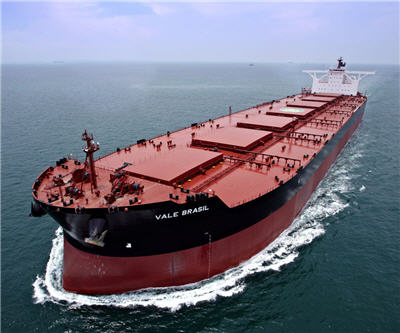Gamechanger: Chinese Valemax ban could be relaxed soon

Number one iron ore producer Vale’s first of 35 mega-carriers capable of carrying 400,000 tonnes of dry bulk cargo embarked on its maiden voyage to Dalian, China in May 2011.
The 362-metre-long and 65 metre wide Valemax class which can carry more than twice as much as the next size dry bulk vessel only made it halfway there.
Then Chinese officials egged on by the country’s shipping firms and steel industry decided ban the giant vessels from the country’s ports over fears of the impact on supply and prices.
While 15 of the giant ships which come with a $100m-plus price tag have already been christened, the docking ban remains in place.
Now the Rio de Janeiro-based company hopes the latest moves by Chinese authorities to open up its industries and trade will mean a fully-loaded Valemax would finally be allowed to directly serve the Asian nation’s market.
WSJ reports (paywall) “Beijing is contemplating a policy shift that could again cede power to individual ports to decide the size of freighters they would accept. Chinese ports are formally limited to allow only ships of as much as 300,000 deadweight tons, though some ports have moved to build facilities that could handle larger vessels like a Valemax.”
Vale Minerals China President João Mendes Faria told the newspaper “no official word” has been received about the Valemax docking ban being lifted, but that “feedback from Chinese steelmakers, shipping companies and ports suggested the direction of revised regulations could be “more positive than negative.”
China forges almost as much steel as the rest of the world combined and to meet the demand for steelmaking raw material China’s iron ore imports have been surging.
Imports of iron ore in August were 69 million tonnes, up 11% from a year earlier. Imports hit a monthly record of 73m in July, which was up 17% from the previous month.
Vale, which controls a quarter of world supply, decided on the VLOC (very large ore carrier) strategy to help it compete with its rivals BHP Billiton and Rio Tinto.
The Australian giants enjoy much shorter and cheaper routes to Chinese ports and have been taking market share from Vale. Australian exports now account for half of Chinese consumption.
Currently 80% of the world’s iron ore is borne by so-called Capesize vessels and Vale has been forced to use transit centres in Africa and a distribution facility in Malaysia and the Philippines to bring ore to its customers in China because of the ban.
The surge in iron ore trade has translated into a massive boost for daily earnings for Capesizes.
Capesize daily rates rose 16.6% to $25,426 on Monday. That represents an astonishing 67% jump from the freight rates recorded at the end of August.
The benchmark CFR import price of 62% iron ore fines at China’s Tianjin climbed to $135.20 on Tuesday, up some 30% up from levels reached this time last year according to data provided by SteelIndex.
{{ commodity.name }}
{{ post.title }}
{{ post.date }}




Comments